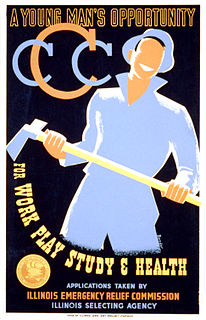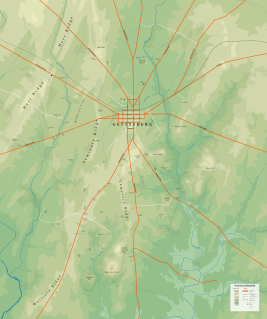Related Research Articles

The Civilian Conservation Corps (CCC) was a voluntary public work relief program that operated from 1933 to 1942 in the United States for unemployed, unmarried men ages 18–25 and eventually expanded to ages 17–28. Robert Fechner was the first director of this agency, succeeded by James McEntee following Fechner's death. The CCC was a major part of President Franklin D. Roosevelt's New Deal that provided manual labor jobs related to the conservation and development of natural resources in rural lands owned by federal, state, and local governments. The CCC was designed to provide jobs for young men and to relieve families who had difficulty finding jobs during the Great Depression in the United States. Maximum enrollment at any one time was 300,000. Through the course of its nine years in operation, three million young men participated in the CCC, which provided them with shelter, clothing, and food, together with a wage of $30 per month.

Gettysburg National Cemetery is a United States national cemetery created for Union/Federal casualties of the July 1 to 3, 1863 Battle of Gettysburg in the American Civil War (1861–1865). It is located just outside Gettysburg Borough to the south, in Adams County, Pennsylvania. The land was part of the Gettysburg Battlefield, and the cemetery is within Gettysburg National Military Park administered by the National Park Service of the United States Department of the Interior.

The Gettysburg Battlefield is the area of the July 1–3, 1863, military engagements of the Battle of Gettysburg within and around the borough of Gettysburg, Pennsylvania. Locations of military engagements extend from the 4-acre (1.6 ha) site of the first shot at Knoxlyn Ridge on the west of the borough, to East Cavalry Field on the east. A military engagement prior to the battle was conducted at the Gettysburg Railroad trestle over Rock Creek, which was burned on June 27.

Seminary Ridge is a dendritic ridge which was an area of Battle of Gettysburg engagements in July 1863 during the American Civil War (1861–1865), and of military installations during World War II (1941–1945).

Big Round Top is a boulder-strewn hill notable as the topographic high point of the Gettysburg Battlefield and for 1863 American Civil War engagements for which Medals of Honor were awarded. In addition to battle monuments, a historic postbellum structure on the uninhabited hill is the Big Round Top Observation Tower Foundation Ruin.

Camp Sharpe was a World War II military installation on the Gettysburg Battlefield that trained soldiers for psychological operations in the European Theater of Operations. Adjacent to Civilian Conservation Corps (CCC) camp NP-2 in McMillan Woods, Camp Sharpe used camp CCC NP-1 and was located "in a muddy hollow at the bottom of a slanting road". A USO facility for Camp Sharpe soldiers was at the former Hill house on Chambersburg Street in nearby Gettysburg, Pennsylvania.

Pitzer Woods is a Gettysburg Battlefield site used for Gettysburg Battlefield camps after the American Civil War such as the 1933–37 Camp Renaissance Civilian Conservation Corps camp.
Plum Run is a Pennsylvania stream flowing southward from the Gettysburg Battlefield between the Gettys-Black Divide on the east and on the west, the drainage divide for Pitzer Run, Biesecker Run, Willoughby Run, and Marsh Creek. The Plum Run Valley was the location of Battle of Gettysburg, Second Day, and Third Day military engagements, as well as the postbellum Crawford's Glen and Tipton Park. In 1972, the Slaughter Pen comfort station was temporarily closed after Youth Conservation Corps participants of Camp Eisenhower discovered fecal pollution in Plum Run.
The World War II Prisoner of War camp on the Gettysburg Battlefield operated from June 29, 1945, through April 1946 at the former site of the McMillan Woods CCC camp.

The Gettysburg Armory is a former National Guard armory located at Gettysburg, Adams County, Pennsylvania. It was listed on the National Register of Historic Places in 1990. The 61x96 ft Art Deco facility was constructed as a $43,331 Works Projects Administration project for the local National Guard unit. The two-story building housed a garage and repair shop for military vehicles, a classroom, administrative space, and a drill hall. From the beginning, the Armory was used not only by the National Guard, but also by the local community, for sporting events and community meetings. In 1944, the Gettysburg Armory was used as a temporary German Prisoner of War camp while the official camp was being constructed on the Gettysburg Battlefield. Later the building was designated as a public fallout shelter by the National Fallout Shelter Survey.
McMillan Woods is a Gettysburg Battlefield forested area used during the Battle of Gettysburg and for camps after the American Civil War, including a CCC camp and the subsequent WWII POW camp at Gettysburg. The woods includes Rifle Pits and Earth Works from the battle

The Pennsylvania State Memorial is a monument in Gettysburg National Military Park that commemorates the 34,530 Pennsylvania soldiers who fought in the July 1 to 3, 1863 Battle of Gettysburg during the American Civil War. The memorial stands along Cemetery Ridge, the Union battle line on July 2, 1863. Completed in 1914, it is the largest of the state monuments on the Gettysburg Battlefield.

The 1938 Gettysburg reunion was an encampment of American Civil War veterans on the Gettysburg Battlefield for the 75th anniversary of the Battle of Gettysburg. The gathering included approximately 25 veterans of the battle with a further 1,359 Federal and 486 Confederate attendees out of the 8,000 living veterans of the war. The veterans averaged 94 years of age. Transportation, quarters, and subsistence was federally funded for each veteran and their accompanying attendant. If an attendant was needed it was provided. President Franklin D. Roosevelt's July 3 reunion address preceded the unveiling of the Eternal Light Peace Memorial; a newsreel with part of the address was included in the Westinghouse Time Capsule for the 1939 New York World's Fair.
Emmor Cope was an American Civil War officer of the Union Army noted for the "Map of the Battlefield of Gettysburg from the original survey made August to October, 1863", which he researched by horseback as a sergeant after being ordered back to Gettysburg by Maj. Gen. George G. Meade. Cope is also noted for commemorative era battlefield administration and designs, including the layout of the 1913 Gettysburg reunion. Cope had enlisted as a Private of Company A,, temporarily detached to Battery C, 5th U.S. Artillery, and mustered out as a V Corps aide-de-camp of Maj Gen Gouverneur K. Warren.

The Wheatfield Road is a Gettysburg Battlefield crossroad from the Peach Orchard east-southeastward along the north side of The Wheatfield, north of the Valley of Death, and over the north foot of Little Round Top. In addition to modern tourist use, the road is notable for Battle of Gettysburg use and postbellum trolley use associated with the 1892-1896 US v. Gettysburg Electric Ry. case of the US Supreme Court.

McPherson Ridge is a landform used for military engagements during the 1863 Battle of Gettysburg, when the I Corps of the Union Army had a headquarters on the ridge and was defeated by the Confederate division of Major General Henry Heth. The ridge has terrain above ~530 ft (160 m) and is almost entirely a federally protected area except for township portions at the southern end and along Pennsylvania Route 116, including a PennDOT facility. The northern end is a slight topographic saddle point on the west edge of Oak Ridge, and summit areas above 560 ft (170 m) include 4 on/near the Lincoln Highway, a broader summit south of the Fairfield Road, and the larger plateau at the northern saddle.

Pitzer Run is a Pennsylvania stream flowing southward between McPherson Ridge and Seminary and Warfield Ridges through the Gettysburg Battlefield to Willoughby Run at the site of Pitzer's School, which was Confederate General Longstreet's headquarters during the Battle of Gettysburg.
The McMillan Woods CCC camp was Civilian Conservation Corps camp NP-2 on the Gettysburg Battlefield planned in September 1933 near CCC Camp Renaissance in Pitzer Woods. Captain Francis J. Moran moved from Camp Renaissance to become the new camp NP-2 commander in October 1933 The camp opened a new recreation hall in 1934 and provided manpower for building the veterans camp for the 1938 Gettysburg reunion, and about 50 enrollees of CCC Company #1355-C served as aides for unaccompanied veterans. During the reunion, Company F of the 34th Infantry used the CCC camp and had a headquarters office under Major C. Gilchrist and Capt. E. E. Wright. Captain Frederick L. Slade was the CCC commander on April 1, 1939.

Camp George G. Meade was one of the Gettysburg Battlefield camps after the American Civil War for Pennsylvania National Guard training of the Keystone Division. The military installation's structures on the Gettysburg Battlefield were subsequently used in the battlefield's commemorative and development eras, e.g., for a WWI recruiting and Tank Corps camp, the 1913 Gettysburg reunion, and the Third Corps camp during the 1938 Gettysburg reunion.
References
- ↑ "Camp Information for NP-2-PA". Pennsylvania CCC Archive. Department of Conservation and Natural Resources. Retrieved 2010-02-01.
- 1 2 Davis, James E. "Gettysburg C.C.C. Camp Men Get Four Days' Leave" (Google News Archives). Baltimore Afro-American . Retrieved 2011-03-17.
- 1 2 "Local Forest Camp No. One Called "Best"". February 9, 1934. Retrieved 2011-03-17.
- ↑ "Change Site of New Camp". September 16, 1933. Retrieved 2010-02-01.
- ↑ "Twister Causes Much Damage as It Sweeps Through Here Sunday". July 3, 1933. Retrieved 2010-03-09.
- ↑ Speakman, Joseph M (2006). At work in Penn's Woods: the Civilian Conservation Corps in Pennsylvania. p. 152. ISBN 0271047372 . Retrieved 2010-02-04.
- ↑ "Says Camp is to be Closed". July 14, 1944. Retrieved 2010-01-31.